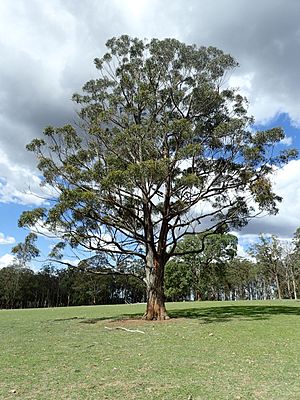Diehard stringybark facts for kids
Quick facts for kids Diehard stringybark |
|
|---|---|
 |
|
| Eucalyptus cameronii near Hillgrove | |
| Scientific classification | |
| Genus: |
Eucalyptus
|
| Species: |
cameronii
|
| Synonyms | |
|
|
The Eucalyptus cameronii, often called the diehard stringybark, is a type of flowering plant. It is a tree that is endemic to eastern Australia. This means it only grows naturally in that area.
It is usually a small to medium-sized tree. It has rough, stringy bark that covers its trunk and even its smaller branches. The adult leaves are shaped like spears or are slightly curved. Its flowers grow in groups of nine to fifteen and are white. The fruit looks like a cup or a half-sphere. This tree mostly grows on the eastern side of the Northern Tablelands in New South Wales.
Contents
What Does the Diehard Stringybark Look Like?
The Eucalyptus cameronii is a tree that can grow up to 40 m (130 ft) tall. It has a special woody swelling at its base called a lignotuber. This helps the tree regrow if it gets damaged.
Bark and Leaves
The bark is rough and stringy. It is grey to brownish and covers the whole tree, even the small branches.
Young plants and new shoots (called coppice regrowth) have leaves arranged in opposite pairs. These leaves are oval to spear-shaped, about 25–70 mm (0.98–2.76 in) long and 9–40 mm (0.35–1.57 in) wide. They are also a different color on each side.
Adult leaves are arranged one after another along the stem. They are shiny green on both sides, or slightly different shades. They are spear-shaped to curved, about 55–130 mm (2.2–5.1 in) long and 8–26 mm (0.31–1.02 in) wide. Each leaf has a stalk, called a petiole, which is about 6–16 mm (0.24–0.63 in) long.
Flowers and Fruit
The flower buds grow in groups of nine to fifteen. They are found on a stalk called a peduncle, which is about 5–12 mm (0.20–0.47 in) long. Each bud is either directly attached (called sessile) or on a very short stalk (called a pedicel) up to 2 mm (0.079 in) long.
Mature buds are shaped like a spindle or are oval. They are about 4–5 mm (0.16–0.20 in) long and 3 mm (0.12 in) wide. They have a rounded or cone-shaped cap called an operculum. White flowers have been seen blooming in March.
The fruit is a woody capsule. It is shaped like a half-sphere or a flattened sphere. It is about 4–5 mm (0.16–0.20 in) long and 4–6 mm (0.16–0.24 in) wide. The parts that open to release seeds (called valves) are at the same level as the rim, or slightly above it.
Similar Trees
This eucalypt looks a bit like E. globoidea. However, the Diehard stringybark has smaller buds and fruit. Its fruit also has a narrower flat part (disc). It is also similar to E. caliginosa, but that tree's fruit valves stick out more from the rim.
How Was the Diehard Stringybark Named?
The Eucalyptus cameronii was officially described in 1934. This was done by two scientists, William Blakely and Ernest Norman McKie. They wrote about it in Blakely's book, A Key to the Eucalypts.
The first sample of the plant used for its description, called the type specimen, was found in the Diehard State Forest near Glen Innes. The second part of its scientific name, cameronii, was chosen to honor Archibald Peter Cameron. He was one of the people who collected the original plant sample.
Where Does the Diehard Stringybark Grow?
The Diehard stringybark grows in forests. You can find it on the hills and steep slopes (escarpments) on the eastern side of the Northern Tablelands. Its range stretches from just north of the Queensland border down to the Cottan-Bimbang National Park. It usually grows in places with poor, shallow soil.
Images for kids



